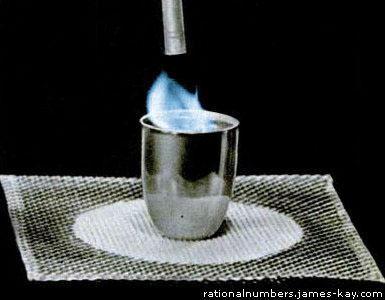Imagine that I have a cup of water and a book of matches. I light one of the matches and tell you that I will now bring the lit match toward the surface of the water. What do you expect to happen?
Your expectation should depend on what you believe about the flammability of water. Consider the following two hypotheses that are relevant to the situation:
- Focal hypothesis: Water is not flammable.
- Alternative hypothesis: Water is flammable.
It’s probably safe to say that the vast majority of people believe the first hypothesis.
Now I bring the match to the water and, unexpectedly, the contents of the cup burst into flames:

Clearly, this observation is consistent with the hypothesis “water is flammable”, and inconsistent with the hypothesis “water is not flammable”. So, after seeing a cup of water burst into flames, this should falsify hypothesis 1 and confirm hypothesis 2…right?
Well…not quite. If you have a reasonably good model of the world in your head, your degree of belief that water is not flammable should be extremely high. Because of this, the observation of burning water should be confusing, and it should make you suspect that maybe something is not as it seems.
It should cause you to think something like “Hmm…maybe that’s not actually water in the cup”. To understand why, lets add one more hypothesis to consider[1]:
- Focal hypothesis: Water is not flammable.
- Alternative hypothesis: Water is flammable.
- Deception hypothesis: We’re not actually observing water burning.
Although seeing the cup’s contents catch fire is consistent with hypothesis 2, it’s also consistent with hypothesis 3.
The idea that water is flammable is probably something you are nearly certain is false. On the other hand, the possibility that maybe I picked up a beaker of gasoline by mistake is not so improbable. So although the observation is consistent with both hypothesis 2 and hypothesis 3, hypothesis 3 is so much more probable to begin with that it remains much more probable after the observation. Thus you should expect that some kind of trickery is occurring, rather than immediately changing your belief about the flammability of water.
This is not to say that you should be dogmatic about your beliefs about the world. Maybe you check everything out, you inspect the cup, you make sure that’s really water in the cup, you try repeating it with other cups of water and they also burn. Under the weight of strong enough opposing evidence you should in principal be willing to eventually change your belief. But your belief that water is not flammable is probably very strong, and so it should require equally strong opposing evidence to change that belief.
So now you have observed my cup of burning water, and this confuses you because it is inconsistent with everything else you know about water[2]. It makes you suspect there is some kind of deception happening – that what you are observing is not as it appears. So you dump out my cup of water and refill it from your own water bottle. You hand the cup back to me and I repeat the experiment and, shockingly, again the water burns! This time surely we’re forced to admit that water does burn, right?
By the way…what’s with the little tube above the cup?

Okay, the jig is up. It’s time to reveal the trick: Water does burn. Sometimes.
The image above is literally a real photograph of water burning. But I am cheating a little bit here. The tube above the cup is carrying fluorine gas, and water actually does burn in a fluorine atmosphere, with a pale bluish-white flame[3].
Admittedly, the fluorine thing is a dirty trick. Hypotheses almost always have assumptions that are not always made explicit. When we say “water is not flammable”, it’s commonly understood that we mean something like “water does not burn in ordinary situations“. So lets modify the hypotheses again:
- Focal hypothesis: Water does not burn in air.
- Alternative hypothesis: Water does burn in air.
- Deception hypothesis: We’re not actually observing water burning in air.
At this point it’s clear that hypothesis 3 is correct, and because of this the observation actually tells us practically nothing about hypothesis 1 and 2[4].
With most hypotheses there are a large number of assumptions that are made, whether they are explicit or implicit. When our models of the world don’t agree with our observations, the explanation often turns out to be that we’re outside the scope of where our hypothesis is supposed to apply.
Even in science, most of the laws are understood to have a scope of applicability, and they aren’t supposed to apply outside of this limited domain. Laws like the law of conservation of momentum, which as far as we know applies always and everywhere exactly and without exception, are the minority even in physics. A big part of understanding science is knowing when the laws apply and when they don’t. For example, Hooke’s law is very successful at describing the behavior of springs, but it’s important to know that if you stretch out a spring too far it won’t spring back to its original shape, and then you can’t use this law any more; you’re outside the scope of applicability for Hooke’s law.
In theory, making a single observation that is inconsistent with a hypothesis is enough to falsify that hypothesis. In practice, however, there’s usually a little work to be done first because there are a few common ways that this process can go wrong. First you need to verify that your observation really is what it appears to be and that there’s no deception occurring. Then you need to check that your hypothesis isn’t being applied outside it’s intended scope. If you check everything out and it turns out that your observation really is something the hypothesis says should be impossible, then you can confidently say that the hypothesis has been falsified.
